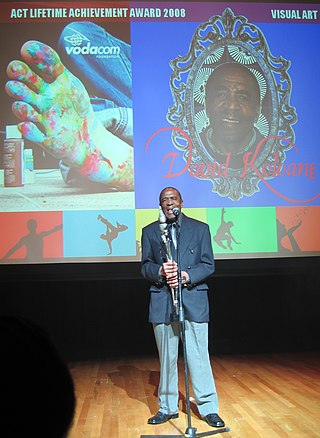
Middelburg is a large farming and industrial town in the South African province of Mpumalanga.

Julie Mehretu is an Ethiopian American contemporary visual artist, known for her multi-layered paintings of abstracted landscapes on a large scale. Her paintings, drawings, and prints depict the cumulative effects of urban sociopolitical changes.
Willie Bester is a South African painter, sculptor and collage artist. He is best known for his role in the protesting of the apartheid system through his artwork. He currently lives in Kuilsrivier, South Africa with his wife, Evelyn and their three children.

Seyni Awa Camara is a Senegalese sculptor from the Diola ethnic group. She was born in Bignona, where she still lives and works. She creates sculptures in clay in her front yard, then fires them in an open-hearth kiln before displaying them around her house. The pieces, ranging in size from 12 inches tall to 8 feet tall, represent personal symbols.

Barthélémy Toguo is a Cameroonian painter, visual and performing artist. He currently splits his time living and working in both Paris, France and Bandjoun, Cameroon. He works in a variety of media aside from visual and performing arts including photographs, prints, sculptures, videos, and installations.
Jean "Johnny" Pigozzi, heir to the CEO of the automobile brand Simca, is an art collector, photographer and fashion designer. He lives in Geneva.

Julie Umerle is an American-born abstract painter who lives and works in London.
Contemporary African art is commonly understood to be art made by artists in Africa and the African diaspora in the post-independence era. However, there are about as many understandings of contemporary African art as there are curators, scholars and artists working in that field. All three terms of this "wide-reaching non-category [sic]" are problematic in themselves: What exactly is "contemporary", what makes art "African", and when are we talking about art and not any other kind of creative expression?

David Nthubu Koloane was a South African artist. In his drawings, paintings and collages he explored questions about political injustice and human rights. Koloane is considered to have been "an influential artist and writer of the apartheid years" in South Africa.
The Contemporary African Art Collection (CAAC) is a private collection created in 1989 by Jean Pigozzi, an Italian businessman. As of May 2022, the collection was based in Geneva, Switzerland, but it "does not have a permanent exhibition venue".
Mequitta Ahuja is a contemporary American feminist painter of African American and South Asian descent who lives in Baltimore, Maryland. Ahuja creates works of self-portraiture that combine themes of myth and legend with personal identity.

Njideka Akunyili Crosby is a Nigerian-born visual artist working in Los Angeles, California. Through her art, Akunyili Crosby "negotiates the cultural terrain between her adopted home in America and her native Nigeria, creating collage and photo transfer-based paintings that expose the challenges of occupying these two worlds". In 2017, Akunyili Crosby was awarded the prestigious Genius Grant from the John D. and Catherine T. MacArthur Foundation.

Marguerite Horner is a British artist who won the 2018 British Women Artist Award. Her paintings aim to investigate, among other things, notions of transience, intimacy, loss and hope. She uses the external world as a trigger or metaphor for these experiences and through a period of gestation and distillation, makes a series of intuitive decisions that lead the work towards completion.
Nina Chanel Abney is an American artist, based in New York. She was born in Harvey, Illinois. She is an African American contemporary artist and painter who explores race, gender, pop culture, homophobia, and politics in her work.
Lovie Olivia is an American multidisciplinary visual artist. She uses the media of printmaking, painting, and installations to explore themes of gender, sexuality, race, class and power.
Amy Sherald is an American painter. She works mostly as a portraitist depicting African Americans in everyday settings. Her style is simplified realism, involving staged photographs of her subjects. Since 2012, her work has used grisaille to portray skin tones, a choice she describes as intended to challenge conventions about skin color and race.

Arpana Caur is an Indian contemporary painter and graphic artist. Arpana Caur exhibits dynamism and deep insight in her depictions of women's conditions in modern India. A self-taught artist, Caur's portrayals of women in urban environments reflect her concerns with the issues of our time: life and death, violence, the environment, and women's issues. Clothing is a recurring theme in her work, both reinforcing and undermining the established image of women.
Mmakgabo Mmapula Mmangankato Helen Sebidi is a South African artist born in Marapyane (Skilpadfontein) near Hammanskraal, Pretoria, who lives and works in Johannesburg. Sebidi's work has been represented in private and public collections, including at the National Museum of Women in the Arts, Washington and New York, the Smithsonian National Museum of African Art, New York, and the World Bank. Her work has been recognised internationally and locally. In 1989, she won the Standard Bank Young Artist award, becoming the first black woman to win the award. In 2004, President Thabo Mbeki awarded her the Order of Ikhamanga in Silver – which is the highest honor given to those considered a "national treasure". In 2011, she was awarded the Arts and Culture Trust (ACT) Lifetime Achievement Award for Visual Art, while in 2015 she received the Mbokodo Award. In September 2018, Sebidi was honoured with one of the first solo presentations at the Norval Foundation in Cape Town – a retrospective entitled Batlhaping Ba Re.
Margaret Courtney-Clarke is a Namibian documentary photographer and photojournalist, living in Swakopmund. Her work "frequently explores the resilience of communities enduring the rapidly shifting landscapes of Namibia." Courtney-Clarke has made a trilogy of books on the art of African women: Ndebele (1986), African Canvas (1990), and Imazighen (1996). She has collaborated on books with David Goldblatt and Maya Angelou.
Cecily Sash was a South African artist, designer, and teacher. She taught design at the University of the Witwatersrand for more than 20 years.












